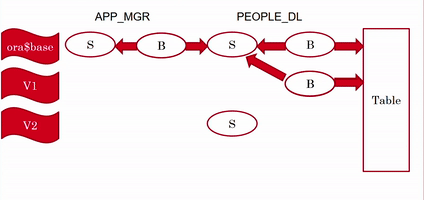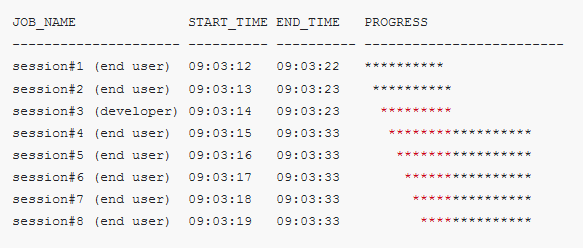Virtual columns were added in Oracle 11g Release 1. We can implement the same concept using views, but one of the advantages that I see in virtual columns is that we can define foreign key constraints on them. Well, we can define foreign key constraints on views as well, but only in DISABLE NOVALIDATE mode, which makes them a decoration rather than a data integrity protector. So to be more precise, we can define enabled foreign key constraints on virtual columns.
This post is about using virtual columns for implementing arc relationships.
In the following ERD, the arc represents the rule “each Entity Address must be owned by either a Person or a Company”:

There are three common ways to implement this logical data model.
Multiple Tables
We can split the ENTITY_ADDRESS entity into two tables – say, PERSON_ADDRESSES and COMPANY_ADDRESSES. Disadvantages of this solution are that we need to maintain two (or more) tables and the code parts that manipulate them, although they are very similar. In addition, if later on we need to add another entity to the relationship (for example, Store, in addition to Person and Company) we will have to add another join table – STORE_ADDRESSES – and the relevant code.
A Single Table with Dedicated Columns
We can implement the ENTITY_ADDRESS entity as a single table – say, ENTITY_ADDRESSES – with a dedicated column for each referenced entity – PERSON_ID and COMPANY_ID (in addition to ADDRESS_ID) – and a check constraint to make sure one and only one of the columns PERSON_ID and COMPANY_ID is not null. The disadvantage of this solution is that we still need to maintain the dedicated columns and the code parts that manipulate them, although they are very similar. And if we need to add another entity to the relationship we will have to add another column to the table and to add the relevant code to manipulate the new column.
A Generic Table
We can implement the ENTITY_ADDRESS entity as a single table – say, ENTITY_ADDRESSES – with a generic column for the referenced entity and a column that stores the entity type to which the generic column references – e.g., ADDRESS_ID, OWNER_TYPE_ID, OWNER_ID. The disadvantage of this solution is that we cannot define foreign key constraints from ENTITY_ADDRESSES to the PEOPLE and COMPANIES tables.
Using Virtual Columns
I’d like to suggest another solution, that, using virtual columns, overcomes the above disadvantages.
This solution is based on the generic table one, but we’ll add also a virtual column for each referenced entity. The purpose of the virtual columns is just for enforcing the referential integrity, and the application should not be aware of them. Therefore, if another entity should be added afterwards, we will add another virtual column, but we will have no code changes to make.
Here it is:
> create table people (
> id integer not null primary key,
> first_name varchar2(30) not null,
> last_name varchar2(30) not null
> );
Table created.
> create table companies (
> id integer not null primary key,
> name varchar2(100) not null,
> number_of_employees integer,
> description varchar2(1000)
> );
Table created.
> create table addresses (
> id integer not null primary key,
> street varchar2(30),
> house_number varchar2(10),
> city varchar2(30),
> country varchar2(30)
> );
Table created.
> create table entity_addresses (
> address_id integer not null references addresses,
> owner_type_id char(1) not null check (owner_type_id in ('P','C')),
> owner_id integer not null,
> --
> primary key (owner_id,owner_type_id,address_id),
> --
> person_id generated always as (decode(owner_type_id,'P',owner_id)) virtual
> constraint address_fk_people references people,
> company_id generated always as (decode(owner_type_id,'C',owner_id)) virtual
> constraint address_fk_companies references companies
> );
Table created.
> insert into people (id,first_name,last_name) values (1,'John','Doe');
1 row created.
> insert into companies (id,name) values (101,'DB Oriented');
1 row created.
> insert into addresses (id,street,city,country) values (1,'Dekel','Zurit','Israel');
1 row created.
> insert into entity_addresses (address_id,owner_type_id,owner_id)
> values (1,'P',1);
1 row created.
> insert into entity_addresses (address_id,owner_type_id,owner_id)
> values (1,'P',101);
insert into entity_addresses (address_id,owner_type_id,owner_id) values (1,'P',101)
*
ERROR at line 1:
ORA-02291: integrity constraint (DEMO5.ADDRESS_FK_PEOPLE) violated - parent key not found
> insert into entity_addresses (address_id,owner_type_id,owner_id)
> values (1,'C',1);
insert into entity_addresses (address_id,owner_type_id,owner_id) values (1,'C',1)
*
ERROR at line 1:
ORA-02291: integrity constraint (DEMO5.ADDRESS_FK_COMPANIES) violated - parent key not found
> insert into entity_addresses (address_id,owner_type_id,owner_id)
> values (1,'C',101);
1 row created.
Hiding the Virtual Columns
Since the virtual columns in this solution are just for enforcing the referential integrity, I prefer to hide them, so adding new entities to the arc (or removing entities from it) will be transparent to the application.
Invisible Columns
In Oracle 12c we can do it by making these columns invisible.
> alter table entity_addresses modify (
> person_id invisible,
> company_id invisible
> );
Table altered.
> select * from entity_addresses;
ADDRESS_ID OWN OWNER_ID
---------- --- ----------
1 P 1
1 C 101
Editioning Views
Being an Edition-Based Redefinition (EBR) evangelist, my application code never refers to tables. Each table is covered by an editioning view, and the application code refers only to views. This practice enables to hide the virtual columns very easily, simply by not including them in the editioning view:
> create editioning view entity_addresses_v as
> select address_id,
> owner_type_id,
> owner_id
> from entity_addresses;
View created.
Unfortunately, EBR is not widely used 🙁
You can, however, use the same idea in non-EBR environment, by creating a regular view rather than an editioning view, and refer to this view from the application code.




